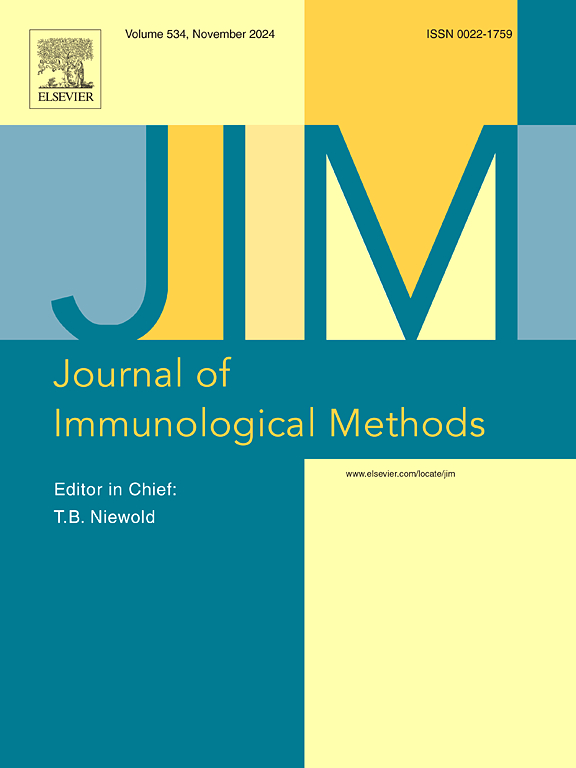针对感染鸡的艾美耳病菌的噬菌体抗体的分离。
IF 1.6
4区 医学
Q4 BIOCHEMICAL RESEARCH METHODS
引用次数: 0
摘要
艾美耳病是家禽生产中最具经济价值的病原体之一。对感染的诊断有可能为治疗和预防策略提供依据。在这里,我们利用噬菌体展示技术分离出了针对家禽中发现的七种艾美耳病致病菌卵囊具有广泛特异性的单链抗体(scFvs)。经过五轮针对七种艾美耳病菌的噬菌体迭代富集(平移)后,从分离出的克隆中随机挑选分离出三种这样的 scFv,代表 2 个 scFv HCDR3 基序。噬菌体抗体与艾美拉虫卵囊的结合也是通过对噬菌体颗粒所含 scFv 基因的 HCDR3 区域进行下一代测序来检测的。该分析表明,经过五轮筛选后发现的最丰富的 scFv 占 scFv 的 90% 以上。 此外,从随机挑选的克隆中分离出的三种 scFv 是每轮筛选中唯一富集的抗体。在噬菌体筛选阶段(选择阶段),它们与艾美耳病卵囊结合,而在噬菌体繁殖阶段(仅生长阶段),它们被筛选出来。对 NGS 数据进行进一步分析后,确定了另外一种 scFv,它在第三轮平移过程中对 3 种艾美耳菌表现出特异性富集,并在平移的选择和生长阶段具有相同的富集模式。对这种噬菌体-scFv 的复苏和分析表明,它对艾美耳菌具有广泛的特异性。在免疫测定中,四种具有广泛特异性的抗体可检测到所有七种艾美耳菌。荧光显微镜进一步验证了这种 scFv 与所有物种的结合。本文章由计算机程序翻译,如有差异,请以英文原文为准。
Isolation of phage-antibodies against Eimeria species that infect chickens
Eimeria is one of the most economically important pathogens in poultry production. Diagnosis of infection has the potential to inform treatment and prevention strategies. Here, phage display technology was used to isolate single chain antibodies (scFvs) that had a broad specificity against oocysts from the seven pathogenic species of Eimeria found in poultry. Three such scFvs, representing 2 scFv HCDR3 motifs, were isolated by random picks of clones isolated after five rounds of iterative enrichment (panning) of phage against the seven Eimeria species. Phage-antibody binding to Eimeria oocysts was also interrogated using next generation sequencing of the HCDR3 region of scFv genes contained with phage particles. This analysis demonstrated that the most abundant scFv found after 5 rounds of panning accounted for over >90 % of scFvs. Furthermore, the three scFvs isolated from random picks of clones were the only antibodies that were enriched through each round of panning. They were also seen to be enriched through the stages of phage panning that included binding to the Eimeria oocysts (selection phase) and to be selected against during the stages that consisted solely of phage propagation (growth only phase). The NGS data was further analysed to identify an additional scFv that demonstrated specific enrichment against 3 Eimeria species at the third round of panning and had the same pattern of enrichment during the selection and growth phases of panning. Rescue and analysis of this phage-scFv demonstrated a binder with broad specificity for Eimeria species. The four antibodies with broad specificity detected all seven Eimeria species in immunoassays. The binding of one such scFv that recognised all species was further validated by fluorescent microscopy.
求助全文
通过发布文献求助,成功后即可免费获取论文全文。
去求助
来源期刊
CiteScore
4.10
自引率
0.00%
发文量
120
审稿时长
3 months
期刊介绍:
The Journal of Immunological Methods is devoted to covering techniques for: (1) Quantitating and detecting antibodies and/or antigens. (2) Purifying immunoglobulins, lymphokines and other molecules of the immune system. (3) Isolating antigens and other substances important in immunological processes. (4) Labelling antigens and antibodies. (5) Localizing antigens and/or antibodies in tissues and cells. (6) Detecting, and fractionating immunocompetent cells. (7) Assaying for cellular immunity. (8) Documenting cell-cell interactions. (9) Initiating immunity and unresponsiveness. (10) Transplanting tissues. (11) Studying items closely related to immunity such as complement, reticuloendothelial system and others. (12) Molecular techniques for studying immune cells and their receptors. (13) Imaging of the immune system. (14) Methods for production or their fragments in eukaryotic and prokaryotic cells.
In addition the journal will publish articles on novel methods for analysing the organization, structure and expression of genes for immunologically important molecules such as immunoglobulins, T cell receptors and accessory molecules involved in antigen recognition, processing and presentation. Submitted full length manuscripts should describe new methods of broad applicability to immunology and not simply the application of an established method to a particular substance - although papers describing such applications may be considered for publication as a short Technical Note. Review articles will also be published by the Journal of Immunological Methods. In general these manuscripts are by solicitation however anyone interested in submitting a review can contact the Reviews Editor and provide an outline of the proposed review.

 求助内容:
求助内容: 应助结果提醒方式:
应助结果提醒方式:


